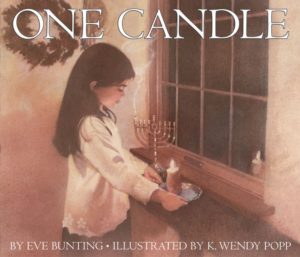Youth Education
for Interfaith Communities
Just like us, our kids are grappling with the human story of the Holocaust. As they learn about it in school, they bring home questions their parents cannot always answer. We can help the youth in your community understand the difficult issues of the Holocaust.
Jump To
For Kids, ages 5 to 12
Programming for Children
Let us bring a program to your community to help your young people understand what they are hearing about the Holocaust. We have some programs already, or we can develop something new for you.
One Candle
For ages 5 to 9
 This gentle introduction to the Holocaust for our youngest students is based on the book One Candle, by Eve Bunting. We use this age-appropriate story to open a discussion of bullying and standing up for each other.
This gentle introduction to the Holocaust for our youngest students is based on the book One Candle, by Eve Bunting. We use this age-appropriate story to open a discussion of bullying and standing up for each other.
One Candle is the story of a young girl who, with her sister, sneaks a potato out of the concentration camp kitchen to make a single Hanukkah candle. Every year since the war, she and her sister make a single candle from a potato to put in the window next to their menorah and tell the story to their grandchildren.
Additional Resources
In addition to our dedicated programs, we have a variety of resources for children of all ages.
Custom Classes
Recommended Reading
Youngsters
Ages 5 to 9
Tweens
Ages 10 to 14
For Teens, ages 13 and up
Programming for Teens
We are looking to develop new programs for teens in an interfaith setting. These programs will be designed to supplement what they are learning in school, and aid them in answering the difficult questions that this topic brings up. Contact us if you are interested in partnering with us on this endeavor.
Holocaust Storytelling
You and your students can become listeners of Holocaust stories and tellers of Holocaust stories.
We can teach you to run a storytelling class, or one of our experienced storytelling teachers can run the project for you.
Students will hear stories from amateur storytellers. Students then to learn to tell the stories of people who experienced the Holocaust. Working with a partner, they will have the opportunity to practice scenes and storytelling techniques in low-stress situations.
They will each choose a story that connects to them. They can work with
- A story that they heard in class
- A story they learned from a memoir, diary, or video
- A story they heard from their family or from a survivor.
Students can learn to tell Holocaust stories from primary text or video sources, without needing survivor involvement, or they can learn to tell stories that they have heard from survivors. By using primary sources, we can tell the stories of victims, as well as the stories of survivors.
Additional Resources
In addition to our dedicated programs, we have a variety of resources for students of all ages.
Recommended Reading
Tweens
Ages 10 to 14
Teens
Ages 15 and up
Follow Us on Facebook & YouTube
© 2020 All rights reserved
